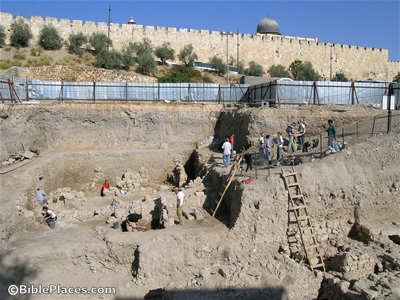מירון רפופורט, המצטט את הארכיאולוג רפי גרינברג, כותב מפיו: “מאז 1967 נסקרו כ-5,000 אתרים ארכיאולוגיים בגדה… ארכיאולוגים ישראלים הם שניהלו את הסקרים, והם העדיפו, כמובן, לסקור אתרים החשובים להיסטוריה היהודית ולא להיסטוריה הפלשתינית… הארכיאולוגים הישראלים חיפשו בעיקר את בית ראשון או בית שני… אך טבעי הוא שארכיאולוגים יתעניינו בהיסטוריה של העם שלהם, ככה זה בכל העולם”.
האמירות האלה של גרינברג אינן מבוססות. כל כוונתו של סקר היא לקבוע את המפה היישובית באזור הנסקר בכל תקופה ותקופה, ולכן אין כל אפשרות להעדיף תקופה אחת על רעותה. כל המעיין בנתוני הסקרים העיקריים שנערכו בגדה לאחר 1967 על ידי זרטל, פינקלשטיין ועופר, יראה מיד שמספרם של האתרים שאינם “יהודיים” שנסקרו) כנעניים, ביזנטיים, מוסלמיים) גדול בהרבה מאלה ה”יהודיים”.
אשר לאתרים שנחפרו – גם כאן התמונה דומה: מאז שנת 2000 הוצאו רישיונות חפירה בגדה המערבית ל-147 אתרים, מהם ניתן להגדיר 14 כ”יהודיים” (20%), מספר קטן של אתרים כנעניים, ואילו הרוב המכריע הוא אתרים מהתקופה הביזנטית והמוסלמית.
דברים אלו נכונים גם לחקר האתרים שבתחומי הקו הירוק: האתרים שבהם נערכות חפירות בקנה מידה גדול בשנים האחרונות ובהם עכו, קיסריה, בית שאן, סוסיתא, בית גוברין, מרישה – אף לא אחד מאלו ניתן להגדיר כאתר “יהודי”. בשנת 2006 הוציאה רשות העתיקות 281 רישיונות חפירה: בכ-100 מאלו נחקרו מתקנים חקלאיים שאת “זהותם האתנית” של המשתמשים בהם לא ניתן לקבוע. בין יתר האתרים, כ-60 הם אתרים בני התקופה המוסלמית, 45-50 הם אתרים נוצריים, 35-40 הם אתרים בני התקופות הכנענית והפרהיסטורית ו-25 (פחות מ-10%) הם אתרים שבהם נחשפו שרידים מימי בית ראשון ושני. נתונים אלה כוללים גם את החפירות בירושלים.
את כל הנתונים הללו קיבלתי מקצין המטה לארכיאולוגיה ומרשות העתיקות בתוך פחות מ-12 שעות מאז פנייתי.
טענות מסוג אלה שטוען גרינברג נשמעות כמעט בכל כנס בינלאומי וכן בפרסומים “מדעיים”, ולצערנו התרגלנו כבר לסילופים אלו שכל כוונתם היא לתקוף את ישראל. גרינברג הכתים לא רק את עצמו, אלא את הארכיאולוגיה הישראלית בכללה. מה חבל, שבדומה לאלו שאינם ישראלים, נתן גם גרינברג להשקפתו הפוליטית לסלף את העובדות.
The following is an English translation of Dr. Amnon Ben-Tor’s Letter to the Editor published in Ha’aretz [Hebrew] on December 29, 2006. It was translated and is circulated with Dr. Ben-Tor’s permission, and also corrects a numerical typographical error made by the paper.
The letter was written in response to an article published in the Ha’aretz Hebrew Language Edition on December 15, 2006. The article was also published in the December 17, 2006 Ha’aretz English Language Edition under the caption “Buried treasure that’s kept in the dark”. The article is based on claims made by Dr. Rafi Greenberg regarding Israeli archaeology and archaeologists. As is evident from his letter, Dr. Ben-Tor takes strong exception to those claims.
*********************
An Archaeological Stain
In response to “Under Command of the GOC Central Command” by Meron Rapoport (Ha’aretz [December 15, 2006]).
Meron Rapoport, who quotes the archaeologist Rafi Greenberg, writes that he says that “Since 1967, some 5,000 archaeological sites in the West Bank have been surveyed…. the surveys were done by Israeli archaeologists and they naturally preferred sites that are important to Jewish rather than Palestinian history…. Israeli archaeologists have excavated mainly the First Temple and Second Temple periods…. It is natural for Israeli archaeologists to take an interest in the history of their people, … it’s the same everywhere.”
These statements of Greenberg are baseless. The whole purpose of a survey is to determine the map of settlement in the surveyed area in every period, and therefore there is no possibility of preferring one period over another. Anyone who studies the data from the main surveys that were conducted in the West Bank after 1967 by Zertal, Finkelstein and Ofer, will immediately see that the number of the surveyed sites that are not “Jewish” (Canaanite, Byzantine and Muslim) greatly exceed those that are “Jewish”.
The picture is similar with regard to the sites that were excavated. Since the year 2000, excavation permits were issued in the West Bank for 147 sites. Of them, 20 can be classified as “Jewish” (14%), and a small number as Canaanite sites, whereas the vast majority are sites from the Byzantine and Muslim periods.
These facts are also applicable to the examination of sites within the Green Line. Of the sites at which excavations were conducted on a large scale, including Acco, Caesarea, Bet Shean, Sussita, Bet Guvrin, Maresha, not even one could be characterized as a “Jewish” site. In 2006 the Israel Antiquities Authority issued 281 excavation permits: in about 100 of these agricultural installations were studied, about which the “ethnic identity” of their users could not be determined. Of the remaining sites, about 60 are Muslim-period sites, 45-50 are Christian sites, 35-40 are from Canaanite and pre-historic periods, and 25 (less than 10%) are sites at which First and Second Temple period remains were discovered. These data also include the excavations in Jerusalem.
I obtained all of these data from the staff officer for archaeology and from the Antiquities Authority in less than 12 hours from when I approached them.
Allegations of the type made by Greenberg are heard at almost every international conference and also in “scientific” publications, and to our regret we have already become accustomed to these distortions which are only intended to bash Israel. Greenberg did not only stain himself but Israel archaeology in general. What a pity that, like those who are not Israeli, Greenberg too has permitted his political opinions to distort the facts.
Amnon Ben-Tor
Jerusalem

